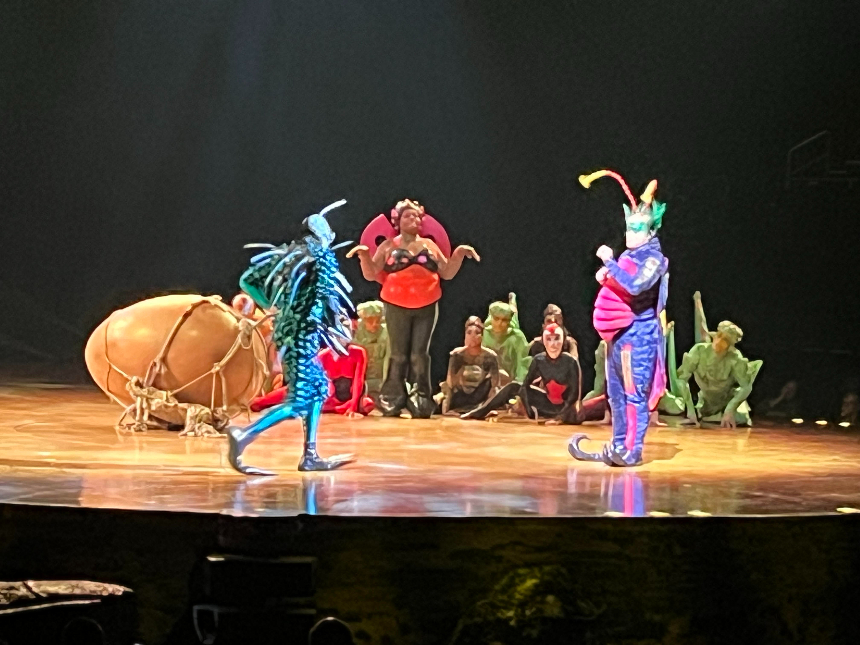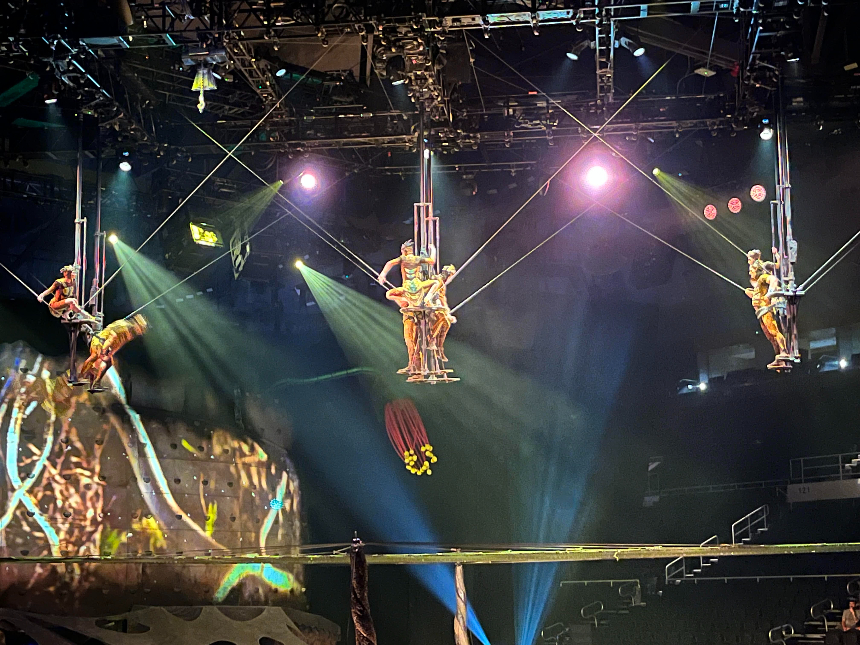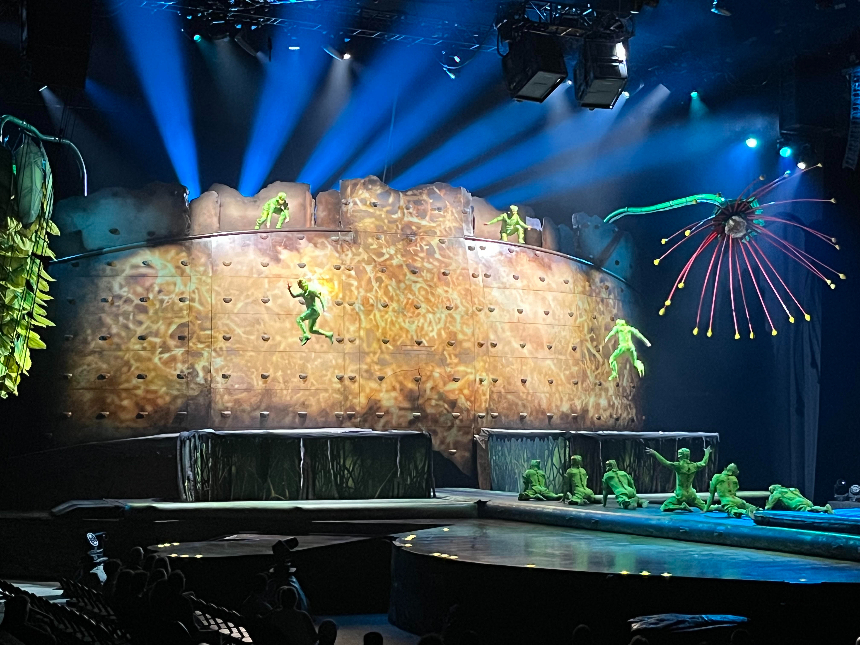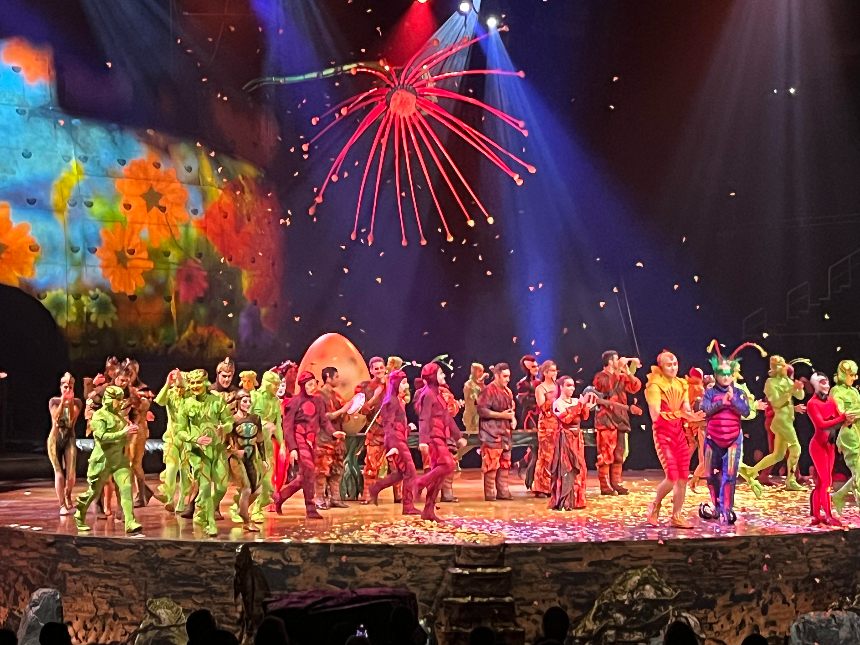Sign up for daily news updates from CleanTechnica on email. Or follow us on Google News!
As we enter the concert seating, sounds of crickets and bullfrogs greet us. An enormous OVO — Portuguese for “egg” — sits on the stage, nearly as high as it is wide: 28′ wide by 22′ tall. The overhead spotlights are chlorophyll green, so we in the audience are basked in the colors of the woodland. It is as if we are plants, merging our human, popcorn-eating, 20-ounce can beer-swizzling, iPhone-fixated selves with the natural world.
The Cirque du Soleil (Circus of the Sun) performance of OVO in Providence, Rhode Island, was fun, and so much more. It was an afternoon immersed in the life of the insects that surround us. It also entertained us with high-level acrobatic acts that redefined the limits of the human body.
OVO invites us to ask questions about the ecosystem below our feet, how different types of insects exist outside our understanding, and how the stories of the most miniature of creatures can compel us to think in new ways about our planet.
 Chip in a few dollars a month to help support independent cleantech coverage that helps to accelerate the cleantech revolution!
Chip in a few dollars a month to help support independent cleantech coverage that helps to accelerate the cleantech revolution!
The Cirque du Soleil imaginative interpretation of the life of insects opens as the huge OVO is suddenly lit from all sides, and multicolored veins circle it. Then the OVO deflates, and a variety of bugs, ants with leaves, grasshoppers, beetles, and aphids takes its place. They climb up a backdrop rock wall, jump across the stage, and pop up and down. A spider hangs at the back of the right stage, its lithe appendages lit with red.
As they move and interact, weave and retreat and reappear, the insects chatter among themselves in a type of bug-talk. Think Minions or R2D2. The bug-talk means that their language is universal — as they climb up and slide down poles, peering stretching, circling, posing handing upside down, the various insects respond to a collective communication that embraces all and Others none.
As is instinctual, the insects play together within species in this early stage of the performance. Red beetles are engrossed in each other, not seeing the grasshoppers emerge. The music changes tempo and so does the pace of the dancing and tumbling. Meanwhile, an acrobat carries an OVO around the base of the stage as a reminder of the cycle of birth, death, and life. It signifies the bewildering puzzle of life cycles.
When one bug flirts with another from a different species — cross pollination! — the grasshoppers sneak in and try to steal the OVO.

While a net full of cocoons appears to the back of stage left, bathed in rich blue and green light, a single cocoon rises at the same time from beneath the stage. It reshapes into a long flowing tube of cloth, and from within it emerges a new bug life. The bug’s awakening is dance — ethereal, graceful, polite, gravity-defying. Then another cocoon replaces it; this high flier is enveloped in a net and mist with a background of red smoke tendrils. Swirling, spinning, dropping nearly to the stage, this blooming insect is energized with the possibilities of life. A violinist plays while insect floor acrobats, more 4-footed than 2-footed, crawl beneath, peer intently, absorb the air, tremble then laugh and gleefully tumble. They are all thrust into a primordial stew where survival and self-preservation exist alongside curiosity about the world around them.
Two bugs disagree in bug-talk about the whereabouts of OVO and mime a sword fight. After being sprayed, one bug falters, and the audience sees that the bottle has a skull and crossbones on it. It is a nod to humans’ destructive impact on the Earth’s ecosystems.
A tube worm with 4 appendages flips, climbs, tumbles. It does cartwheels, handstands, backwards walkovers, and springs — all the while viewing the world in a way that no humans can, due to its two enormous black eyes. And then, when two katydids enter the stage — twig-like, on stilts, with stick arms that grasp at the insects around them — they threaten to upend the daily pattern of insect life. It is not until the OVO seeker and his new love, the ladybug challenges them with bug-talk and they exit, chagrined. Calm returns.
Dueling musicians keep our attention, yet several ladders are being hoisted over a net. The Trapeze! The insects are flying, tossing each other from one platform to another while the ground-dwelling insects living in a vibrant rainforest look on. Olympic athletes Olga Shcherbatykh (Ukraine 🇺🇦 2004) and Nansy Damianova (Canada 🇨🇦 2008) competed in artistic gymnastics competitions before joining the show.

Following an intermission in which several people of various ages return to their seats with butterfly headbands or miniature hats encased in flowers or hand-held OVOs that are internally lit, the Queen Bee enters and serenades us with a soothing bug-talk ballad. Her bodice/ carapace is a hard material while the rest of her body is draped in orange and black flowing cloth. A red bug emerges from the stage floor and saunters across the stage, carrying an oblong lit OVO.
Next it are yellow-and-red striped bugs on the Trapeze that flip, curl, climb, hang by their knees, and pose, frozen in time. All have costumes that capture the most vibrant colors of nature. With toes pointed, swaying, grasping a leg there, an arm here, they form one body then separate into two distinct individuals. They are unified yet apart, part of a collective conscious but also single-minded — the product of survival of the fittest but also evolution, so that they can only exist if they protect each other and, ironically, adapt.
Three scarabs — with Ozzie Ozbourne-like with costumes variations of the same black, red, and white, Edvard Munch scream masks, and mullets — do floor exercises, holding all their weight on a single finger, inverting into rolls, walking backwards on their hands. They are strong and scary, a force with which to be reckoned. Meanwhile, the Queen Bee sings, and the cocoon hangs in brilliant green and yellow light, contracting and expanding as the life forces within it grow toward birth.
A contortionist bends her body beyond any human expectation — front-bending, back-bending, splits, and over-splits — while holding herself upside down on a circular balance beam. While we’re mesmerized, a large-ish OVO is carried across the stage as a reminder of how love renews ourselves and life. It symbolizes fragility and our need as a community to take care of the next generation.
Flowers burst in the backdrop video roll. Cirque du Soleil worked with 4U2C to integrate projections throughout the show — it took over 40 days to shoot the miniature forest built from real plants with a tech goal to represent a tableau with 24’ x 8’ dimensions. A team of 30 artists was involved in the production of video content.
Green bugs appear from within the projection, climb the actual rock wall — which measures 64′ wide by 30′ tall — then fall onto trampolines beneath them. They bounce back up and re-climb the wall while floor gymnast insects run and flip in midair. The rock climbing bugs fall in sequence and bounce back up to the wall while the floor insects do back flips and handsprings and walkovers. It is precisely choreographed chaos — the Crouching Dragon of the bug world, where feats beyond normal human mobility, capacity, or endurance are part of the lifecycle.

In the grand finale, in which all the insects are on stage, a whirl of motion and color and light consumes the stage. The acrobats pause, and the audience thinks the show has ended. Then the OVO cracks, light pierces outward, and a new cycle of life begins.
The press kit from Cirque Du Soleil describes the show as “non-stop riot of energy and movement. The insects’ home is a world of biodiversity and beauty filled with noisy action and moments of quiet emotion.” Guy Laliberté recognized and cultivated the talents of the street performers from the Fête foraine de Baie-Saint-Paul and created Cirque du Soleil in 1984. In 2007, Guy Laliberté entered into a second lifetime commitment by creating ONE DROP to fight poverty around the world by providing sustainable access to safe water. This dream stems from the knowledge that the right to water is key to the survival of individuals and communities all over the world and from the values which have been at the heart of Cirque du Soleil since its inception: the belief that life gives back what you have given and even the smallest gesture will make a difference.
With 100 people from 25 different countries, including 52 artists, OVO has thrilled more than 7 million people in over 160 cities since its 2009 opening.
“The hidden, secret world at our feet is revealed as tender and torrid, noisy and quiet, peaceful and chaotic,” the press release explains. “And as the sun rises on a bright new day the vibrant cycle of insect life begins anew.”

Have a tip for CleanTechnica? Want to advertise? Want to suggest a guest for our CleanTech Talk podcast? Contact us here.
Latest CleanTechnica.TV Videos
CleanTechnica uses affiliate links. See our policy here.
CleanTechnica’s Comment Policy





